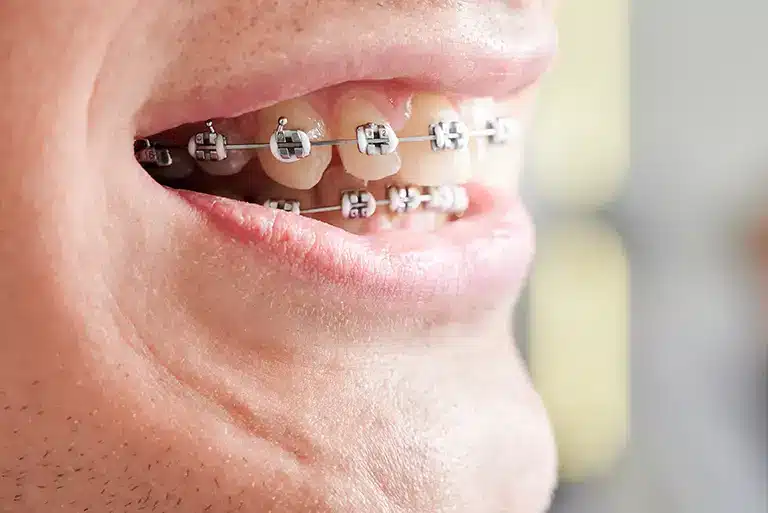Are you worried about the cost of braces for yourself or your child? Did you know that dental insurance can help cover these expenses? Many people are unaware of how dental insurance plans work when it comes to braces. Understanding your dental coverage can save you a significant amount of money.
Let’s explore the various aspects of dental insurance coverage for orthodontic treatments.
Does Dental Insurance Cover Braces?
Yes, many dental insurance plans offer coverage for braces. However, the extent of coverage can vary significantly based on the type of dental policy, the insurance provider, and specific plan details. Some include orthodontic services under comprehensive plans, while others categorize them as major procedures. It’s important to review your dental policy to understand the specific orthodontic benefit provided. Keep in mind that waiting periods, annual maximums, and lifetime maximums can affect your coverage.
What Types of Braces Are Covered By Dental Insurance?
- Traditional Metal Braces. These are the most common types of braces covered by dental insurance. Many plans categorize them under basic dental care services. Delta Dental and other major insurance companies often include these in their dental insurance coverage.
- Ceramic Braces. Some plans cover these less visible braces but may involve a higher out-of-pocket expense. Coverage for ceramic braces can vary based on your insurance provider and the specific dental insurance policy you hold.
- Invisalign. Coverage for Invisalign varies widely. Some dental insurance providers include it under their orthodontic coverage, while others consider it a cosmetic procedure. It’s essential to verify the extent of coverage for these aligners with your insurance company.
- Lingual Braces. These braces, which are placed behind the teeth, are sometimes covered but often categorized as advanced orthodontic treatments. Due to their specialized nature, the coverage level can differ significantly depending on the type of dental plan you have.
- Aligners for Teeth. Clear aligners may be partially covered, depending on the orthodontic insurance plan. Family dental plans often include such options, enhancing the scope of orthodontic care available.
5 Common Dental Insurance Plans That Include Braces
1. Delta Dental PPO
Delta Dental’s PPO plan often includes orthodontic treatments as part of its dental benefits. This coverage may offer lower coinsurance amounts, reducing the patient’s out-of-pocket expenses. Additionally, Delta Dental provides larger annual maximums, which can be beneficial for extensive orthodontic work.
2. Spirit Dental
Spirit Dental offers plans with no waiting periods and comprehensive orthodontic coverage. These dental insurance plans are useful for both children and adults who need braces. The lack of a waiting period means patients can start orthodontic treatments immediately after enrolling.
3. Ameritas PrimeStar Access
Ameritas’ PrimeStar Access provides extensive orthodontic services, making them a robust insurance option. Coverage often includes traditional braces, ceramic braces, and Invisalign, offering flexibility in orthodontic treatments. These insurance cater to different orthodontic needs and preferences.
4. DeltaCare USA HMO
DeltaCare USA HMO typically requires patients to use network providers but often covers a significant portion of orthodontic costs. This includes coverage for metal braces and ceramic braces, helping to manage orthodontic expenses. Using network dentists ensures higher dental benefits and lower out-of-pocket costs.
5. Aflac Dental Insurance
Aflac Dental Insurance offers various levels of orthodontic coverage. The extent of coverage for braces could be substantial, depending on the specific policy. Aflac often caters to both children and adults, making it versatile for family dental needs.
What Dental Insurance Covers Braces for Adults?
Dental insurance for adults often includes coverage for braces, although the extent of coverage can vary depending on the dental policy and insurance provider. Many comprehensive plans categorize orthodontic treatments for adults as major procedures, offering partial coverage for traditional metal braces, ceramic braces, and sometimes Invisalign. The coverage might come with a waiting period, annual maximums, and a lifetime orthodontic maximum.
Some plans, like those from Delta Dental or Spirit Dental, provide specific benefits for orthodontic care, helping to reduce pocket expenses. It’s important to review the details of your specific insurance to understand the level of orthodontic coverage available to you.
How to Determine If Your Insurance Covers Braces
Review Your Insurance Benefits
Check your dental plan materials to identify whether braces are included under orthodontic services. The brochure will detail the types of braces covered by your dental insurance. Understanding plan details helps you gauge the extent of coverage.
Check Waiting Periods
Look into the waiting period before coverage kicks in for orthodontic treatments. Many insurance plans have a 12-month waiting period for orthodontic treatments. Knowing this waiting period helps you plan your orthodontic care accordingly.
Contact Your Insurance Provider
Reach out to your insurance provider for specific details about your plan. They can explain authorization requirements and the maximum benefits available for orthodontic treatments. This step ensures clarity about your insurance coverage for braces.
Understand Lifetime Maximums
Be aware of the orthodontic lifetime maximum listed in your dental policy. This is the total amount your insurance will pay for orthodontic care over your lifetime. Knowing your lifetime maximum helps in financial planning for orthodontic treatments.
Consult With Your Orthodontist
Your orthodontist can offer insights into how your insurance will cover the braces, including any additional costs you might incur. They are familiar with different insurance plans and can help you navigate your dental coverage. This consultation helps in estimating pocket expenses for your orthodontic care.
How to Maximize the Benefits of Your Dental Insurance for Braces?
Stay In-Network
Using network providers ensures you get the highest level of dental coverage for braces. Network orthodontists generally have negotiated rates that are lower than out-of-network providers. Staying in-network reduces your pocket expenses for orthodontic treatments.
Utilize Preventive Visits
Regular dental visits can detect orthodontic issues early, potentially reducing the need for extensive treatments. Preventive care is often covered by dental insurance, contributing to overall oral health. Early detection and preventive care help in managing dental care costs.
Monitor Coverage Levels
Keep track of your annual maximums and lifetime benefits to avoid surpassing your insurance coverage limits. Monitoring your coverage levels ensures you maximize your dental benefits without incurring additional costs. Staying within your coverage limits helps you manage your budget effectively.
Consider a Secondary Plan
If orthodontic care costs exceed your current dental policy’s limits, a secondary plan may provide additional coverage options. Having dual coverage can help cover orthodontic costs not paid by your primary plan. This approach reduces pocket costs and enhances your insurance coverage.
Understand Coinsurance and Copayments
Be clear about the coinsurance structure and copayments in your insurance plan. This understanding helps you manage your pocket costs effectively. Knowing the coinsurance amounts and copayments ensures better financial planning for orthodontic care.
How to Choose the Right Dental Insurance for Braces
Evaluate Coverage Options
Choose an insurance option that offers robust orthodontic care benefits. Comprehensive plans typically include braces and other necessary orthodontic appliances. Evaluating coverage options ensures you select a plan that meets your orthodontic care needs.
Check for Annual Caps
Compare annual benefit maximums across various dental insurance plans. Higher caps on annual benefits mean better coverage for braces and fewer out-of-pocket expenses. Checking annual caps helps you identify the most beneficial dental insurance.
Compare Plan Costs
Look at the monthly premium, coinsurance amounts, and overall costs for each plan to find a budget-friendly option. Considering these factors ensures you select a plan that provides adequate coverage without straining your finances. Comparing costs aids in balancing insurance coverage and affordability.
Read Reviews
Check reviews of premium levels and policy coverage from existing policyholders. Feedback from other customers can offer a realistic view of the dental insurance benefits and limits. Reading reviews helps make an informed decision about the right dental insurance for braces.
Consult Insurance Providers
Speak with dental insurance providers to understand the extent of coverage, including braces for adults and children. Discuss any additional costs involved and how different plans compare regarding coverage levels. Consulting providers ensure you select a dental insurance plan that adequately covers orthodontic care for your family.
Maximize Your Dental Insurance Benefits With Casey Dental Today
Effective dental insurance coverage for braces can make achieving a beautiful smile more affordable. Reviewing your dental benefits plans and understanding orthodontic coverage is essential. With the right dental insurance plan, you can reduce the cost of braces significantly.
At Casey Dental, we understand the importance of orthodontic care. Our team is here to help you with your dental insurance plans to maximize your coverage for braces.
Schedule an appointment today to discuss your dental coverage or explore new insurance options to ensure you receive the best care possible. Let us help you achieve a beautiful smile with fewer pocket expenses.
Frequently Asked Question
What types of braces are typically covered by dental insurance?
Dental insurance plans may cover various types of braces, including traditional metal braces, ceramic braces, and sometimes clear aligners. However, the coverage specifics can vary depending on the insurance provider and the individual plan. It is essential to review your policy details to understand what types of braces are included under your coverage.
Do dental insurance plans cover braces for adults?
While many dental insurance plans offer coverage for orthodontic treatments, adult coverage can differ significantly. Some plans provide orthodontic benefits for both children and adults, while others may limit coverage to minors. It’s important to verify with your insurance provider to determine if your plan includes orthodontic coverage for adults.
What factors can affect the coverage of braces under dental insurance?
Several factors can influence braces coverage under dental insurance, including the type of dental policy, the specific insurance provider, and plan details such as waiting periods, annual maximums, and lifetime maximums. Understanding these elements can help you estimate potential out-of-pocket costs and plan your orthodontic treatment accordingly.


